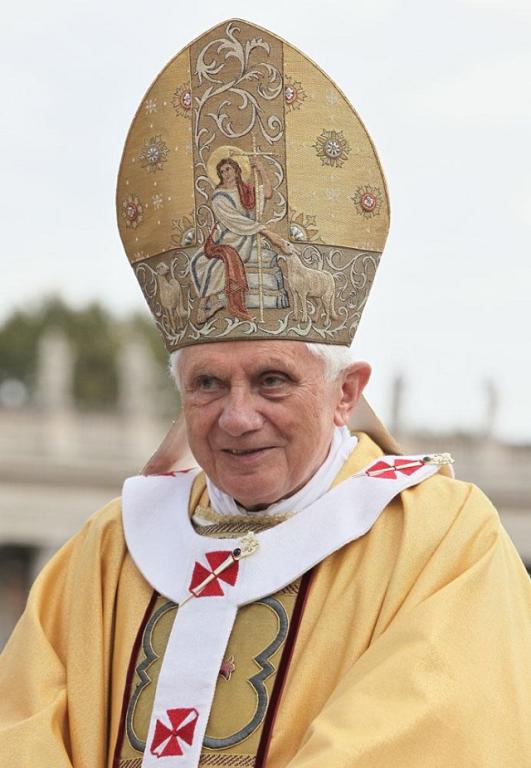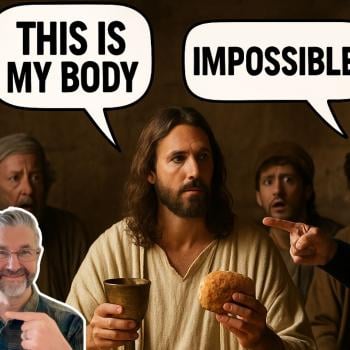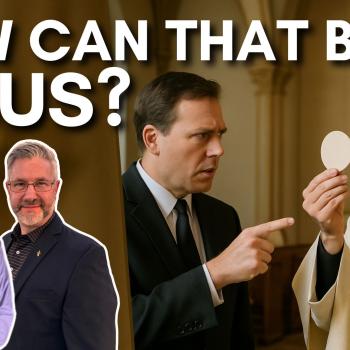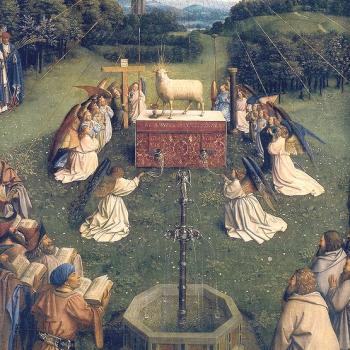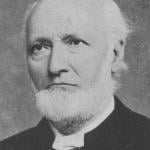(Pope Benedict XVI’s 2007 Decree That Widely Allowed the Tridentine Mass)
Various entries from my Facebook page:
My position is that of the Holy Father: both the ordinary and extraordinary forms are good. Why do we have to say one is “better” than the other? Why do we have to categorize any of the 22 Catholic rites? We don’t say one book in the NT is “better” than another. The only reason I even have to defend the Pauline Mass is because it has been savaged and pilloried mercilessly by the radical Catholic reactionaries [see the definition of this group, over against traditionalists] and because of the myriad liberal and ignoramus abuses of it.
I don’t have any burden of trying to prove that the Pauline is “better” than the TLM, because that is not my position anyway. It’s you guys who say that one is “better” than the other.
What I’ve argued is that the Pauline Mass has as much support from Tradition as the TLM, and that the Church had good reason to promulgate it. It’s not merely the largely subjective argument of the traditionalists and the separate group of the reactionaries who aren’t arguing for an intrinsic evil or invalidity but that the TLM is “better” or “best.”
I would say at most (with regard to this comparison thing) that the Pauline Mass does succeed in its aim to be more suited to contemporary times. Even Trent said that was a permissible goal.
Why the continued carping on and on about how inferior the Pauline Mass is? Why not just worship as you see fit and the allow others to do the same? If the Holy Father has done what Msgr. Gamber recommended (and the latter’s book is the book that mainstream traditionalists want to recommend regarding liturgy) then where is the beef? The pope has clearly stated that both are here to stay.
The Holy Father has given his firm opinion on this issue (with less than ex cathedra authority). Will the traditionalists accept this or not? Even Gamber apparently conceded that the Pauline Mass was not going to go anywhere.
You have it exactly backwards. As I’ve stated several times, I am enthusiastically in favor of letting Catholics worship as they please. I love the new universal indult and think it was way overdue. I’m not arguing that the Pauline Mass is “better” than the Tridentine. I’m saying it is meaningless and divisive to engage in those quarrels, since the Holy Father has stated that both will be maintained and that both are forms of the Roman rite.
I defended the Pauline Mass because reactionaries continue to bash it as if it has no rationale or historical precedent. And of course that ruffles lots of reactionary (and even some traditionalist) feathers because no one is supposed to make such arguments, even on the stumbling, bumbling, preliminary, introductory level, as in my case.
* * *
I just had at my party yesterday the priest at my parish who celebrated the Tridentine Mass yesterday ( [name] ). He thinks it is atrocious and divisive for reactionaries to continue complaining, especially after the universal indult has been granted. Also at my party was a professor of theology, [name]. He said that it was scandalous and unseemly for reactionaries to continue this line of protest by virtue of the principles of Catholic assent to magisterial utterances (even if sub-infallible).
Reactionaries should sensibly cease comparing the extraordinary and ordinary forms of the Roman rite to the detriment of the latter: and that for the good of the Church and unity.
Both reactionaries and mainstream traditionalists have gotten what they wanted: freedom to worship as they please and prefer, and compete latitude for availability of the TLM potentially, if not actually, in every parish.
Now, that would seem (to the hypothetical “neutral” observer) more than sufficient to allay their central (?) concerns about the modern Church. But I would have predicted (I don’t think I actually did, but I quite possibly could have) that this wouldn’t be good enough, and that they would continue to gripe and find something in the Church to excoriate.
Looks like I would have been right if I did that, though the new situation seems to have at least taken the wind out of many reactionary sails, and to have stolen a great deal of their fire: which was, of course, part of its purpose. If something is causing schism or significant and troubling sub-schismatic division and discontent (apart from the complex question of causation) and one (i.e., a pope) can do something to lessen that potentiality and tendency, and to strengthen existing Catholic norms and practices, then it is good to do so.
I have been in favor of this latitude in freedom of worship all along. It was wrong to suppress the TLM. Likewise, it is equally wrong (and hypocritical, given this recent history) for reactionaries to want to suppress the Pauline Mass entirely, in favor of the TLM (or to begrudgingly accept it as “valid” and “licit” etc. while constantly running it down).
I think there has been some confusion in liturgical matters, even at the highest levels. We can wholeheartedly agree on that. My own desire is to see all factions move ahead by accepting the Holy Father’s Motu Proprio.
I’m not the one to figure out all these little details. I have no desire to do so and I don’t feel that I have to. I can’t explain all that. I don’t have it all figured out by a million miles. But the Church is our Guide and Mother. We’ve been shown the way to move ahead and beyond this internal conflict.
I think y’all should drop the incessant criticisms of the Pauline Mass. You don’t like it. You have huge problems with it. We get that. But you’ve now been allowed to worship as you want to, without feeling like you’re disobedient or sneaking around in the shadows, wondering whether it is right to go to an SSPX chapel and what-not. That’s all history, or should be. Let us worship as we see fit, too, without being regarded as second-class, spiritually stunted Catholics who know little about legitimate liturgical tradition. This is divisiveness. Perhaps my approach (which is the pope’s: liturgical tolerance and latitude) is the right way to go?
With those preliminary thoughts, I got very curious as to how reactionaries have reacted to the new situation of the universal indult. The first truly I found in my searching was the good ole Remnant, (a textbook reactionary organization) and Michael J. Matt: an article that came out even before the universal indult was granted. The approach was entirely predictable, and perhaps gives indication of what we can expect to see a lot in the future from reactionary circles:
If and when the Pope does enact concrete measures along traditionalist lines he will be crucified. . . .
The international traditional Catholic movement—including the SSPX, the Fraternity of St. Peter, Independent chapels, the Institute of Christ the King, tradition-minded Indult priests, etc., have—to varying degrees—managed to preserve the traditional Mass through forty years of liturgical “shock and awe”. Do we really want that jealously guarded treasure to become the plaything of Fr. Elton John? Are we ready for Palestrina meets Joan Baez?
On the other hand, wouldn’t Father Elton John and his happy-clappy congregation be about as receptive to the old Mass as are the French bishops? The Tridentine Mass is to the liberal what holy water is to the vampire. Wouldn’t the universal indult, therefore, succeed mainly in providing sanctuary to those priestly prisoners of the Novus Ordo Gulag who have managed to keep the faith but who have grown sick to death of the protestantized new Mass? It would seem so. . . .
The indult has its drawbacks, of course. The Remnant has, in fact, led the charge over the past two decades against the “Indult Mentality,” which would have traditionalists swap their public resistance to the revolution for permission slips to have the Mass they “prefer.” Mirabile dictu, the “Smile and Obey Your Apostate Bishop” crowd seems to be dispersing while militant lay traditional Catholics—in both approved and unapproved Mass centers—are putting jackhammers to the base of the great façade of neo-Catholicism.Total rejection of the “new ecclesial orientation” of Vatican II is what fueled the traditional Catholic counterrevolution since 1969. It wasn’t Archbishop Lefebvre’s “liturgical preferences” that prompted the motu proprio Ecclesia Dei and brought down modernist wrath upon his head; it was his resounding NO to the New Mass and the destructive “spirit” of the Second Vatican Council. . . .
Look around! The Novus Ordo is dying while Traditionalism is thriving. Why should we change the formula now? . . . The neo-Catholics are falling all over themselves in a desperate effort to appear more traditional, many even applying the term to themselves. . . .
The party, mercifully, is over, and Catholics from the lowliest pew to the throne of St. Peter are coming to realize that something must be done. In a few days, the Holy Father himself is expected to extend his hand over the universal Church and solemnly proclaim that, at least liturgically, the traditionalist resistance has been justified all along. The old Mass must be restored.
Imagine that!
But even when this happens, if it happens, can there be any doubt that, after so much betrayal and revolution, the SSPX lifeboat must remain anchored precisely where it has always been, safely beyond the vortex of the sinking Novus Ordo? The “insurance policy” can not be cancelled until Rome’s recognition of the full extent of the crisis takes the form of a total recall of the disastrous Novus Ordo—liturgically, theologically and philosophically.
One mainstream traditionalist (with whom I have had several constructive dialogues lately) made very clear his own opinion shortly before the “MP” came out:
Lastly, it would appear that there is little I can do here to convince you of the repugnance of the Novus Ordo. Yet when one goes to the Traditional Liturgy for a period even years, and then goes back to it, can scarcely recognize it as his liturgy. I know I went because I couldn’t afford the gas to make it to a traditional Mass, and I walked out. I felt like a protestant. More to the point I felt like a Muslim who witnesses someone eating in the Mahsjiid during Rhamadan. I couldn’t deal with it. When one has such an experience, it forces him to ask the question, the Traditional Mass was used by Catholics in virtually the same form for 1600 years. Going to it makes me view the new liturgy which was composed by a team of liturgists in 1967 as protestant, what is wrong with the new liturgy? Thus I am a traditionalist and I only go to the Traditional Mass.
* * *
I support the eventual dissolution of the Novus Ordo and the return to organic development from the old, which is what Vatican II called for. It called for organically developing the liturgy at hand, which was the Tridentine Mass, albeit the Vatican II document short circuits its own goal. The question is how to go about it. We had one liturgical supression and it caused disaster. Intelligent people would not want another one. The solution really is put the Traditional Mass out there, let people experience it, or let Tradition stand for itself. Over time, I believe the Novus Ordo will just disappear.* * *
Once the new decree was promulgated on 7 July 2007 [along with its important accompanying letter to the bishops], one could trace reactionary and traditionalist reaction and see how they would react to the continuing legitimate status of the Pauline Mass. This person’s own reaction is illustrative:
The first problem with the document is the claim that the Novus Ordo and the Traditional Latin Mass are part of the same rite. Two expressions of the same lex credendi. That this is fictitious can be found from the Pope’s own words several years ago, when he declared in the preface to Monsignor Klaus Gamber’s book on the reform of the liturgy that the Novus Ordo was a “banal, on the spot product.” How can such a thing, a theater liturgy tailored to the uses of modern man be the ordinary expression of the “Roman rite”? What he is basically saying with Summorum Pontificum is that what he himself declared a banal on the spot product is a liturgy which has the preference of the Church, over the Mass of the saints. This liturgy, which would claim the role of usurper, is not even 40 years old yet. It is rife with innovation after innovation (even in the Latin), and is in and of itself a hermeneutic of discontinuity. . . .
Thus, call the whole thing what you will, it is not an expression of any kind of the Roman Rite. Is it a Mass? Certainly. That is not the issue, the issue is that it has no part of Latin Catholic patrimony, other than a hodgepodge of different traditions that find their way into the Latin, but bear no resemblance to the recognizable liturgy of 1800 years of Western Catholicism.
This bears down on the heart of the flaw of Summorum Pontificum. If the so-called “ordinary” celebration (a term I reject in fact) is not apart of the same Roman Rite, how can it function as a stabilizing, ordinary liturgy, when it is in itself constantly changing and not even 40 years old? It can not. One must supplant the other, because the stable body of our tradition is stronger than the endless options of a narcissistic liturgy obsessed with itself.
I think it is fairly (though not perfectly) clear in context, that the pope was speaking of abuses of the Pauline Mass, not the thing itself. This is a crucial distinction. If he was not doing this, then he has either contradicted himself or has assumed a less critical opinion of the Pauline Mass itself (celebrated in a non-corrupted fashion, according to its actual rubrics).
Reactionary scion John Vennari doesn’t miss a beat in roundly disagreeing with the Holy Father in August 2007, writing in the notorious reactionary rag Catholic Family News:
The Motu Proprio contains numerous oddities, the most prominent of which is its claim that the Novus Ordo and Latin Tridentine Mass are two forms of the one Roman Rite: the Liturgy of Pope Paul VI is the ordinary form, and the Latin Tridentine Mass is the extraordinary form. . . . Pope Benedict’s letter to the bishops that accompanied the Motu Proprio goes on to say “There is no contradiction between the two editions of the Roman Missal” This is simply not true. . . . Clearly the New Mass represents a destruction of the Roman Rite, not an “ordinary” form of it. So why does Pope Benedict XVI present a new “ordinary/extraordinary” formula that appears to defy reason? Does he really believe in it? Or did he present this novel dichotomy as the only way he perceived the world’s bishops would accept his document? . . . It is absurd to claim there is “no contradiction” between a liturgy that disgusts Protestants (the Traditional Mass, which Luther called worse than the most loathsome brothel); with a liturgy that delights Protestants (the Novus Ordo).
The New Mass was not constructed to be a clear expression of the Catholic Faith, nor was it designed for the proper worship of God that is His due. It was formulated, rather, as surrender to Protestantism for the sake of a bogus ecumenism. . . . The New Mass is not truly a Catholic liturgy, but an ecumenical one. It was designed to accommodate those who reject the most basic tenets of the Catholic Faith; such as the sacrifice of the Mass; the sacrificing Catholic priesthood; and the real presence of Our Lord in the Holy Eucharist. Thus it is absurd to claim this protestantized liturgy is the ordinary form of the Roman Rite. Nothing is gained by pretending this absurdity does not exist.
Reactionary J. Hughes Dunphy waxes eloquent four days after the Motu Proprio came out:
In light of this litany of seemingly endless disrespect and sacrilege can one any longer doubt the denial of Jesus Christ and His Divine Presence as being total and complete by the Judas Priests of the “Novus Ordo Missae” and communion in the hand along with its boon ally, Liberal Protestantism?
Mainstream traditionalist Ben Douglass opined (6-23-08 on my blog):
The whole thesis under dispute here is whether the Tridentine Mass possesses an objective and demonstrable theological superiority over the Novus Ordo. Given that I believe this to be the case, not only do I wish myself to be able to attend the Tridentine Mass, but I want the entire Latin Rite to return to the Tridentine Mass (and the unreformed Ambrosian, Mozarabic, Dominican, etc.), for the greater glory of God and the salvation of more souls. . . . It would be harsh and imprudent to suppress the Novus Ordo immediately. It is good and praiseworthy to work and pray that it will be suppressed and replaced eventually.
It looks so far like we won’t see an acceptance among reactionaries (or even a fair number of traditionalists) of the sort of “tolerant liturgical pluralism” of Pope Benedict XVI’s much-discussed Motu Proprio. They will (by all appearances) continue to clamor and prattle on about how terrible the Pauline Mass is, after having complained, lo these many years, about the Tridentine Mass being denigrated. Their dilemma is that the Holy Father (to the chorus of great acclamations and praise) has given them what they wanted, but alongside that (man, why must there always be a catch?), he has reiterated that the Pauline Mass is the continuing “ordinary” form of the Roman rite.
This is not totally acceptable to the average mainstream traditionalist and certainly not to the reactionary. They want the Pauline Mass suppressed and abolished. Nothing less will do. But this plainly clashes with the expressed will of Pope Benedict XVI (and I would say, the Mind of the Church). So what do they do? Go against the Church, in persisting in these opinions, or cease the protests along those lines and worship in their fashion without feeling an intense need to run down other legitimate forms of Catholic worship? We’ll see! Time will tell.
*****


